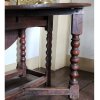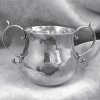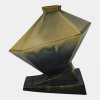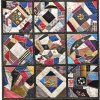Casual Country Style Tempts New Generation
October 17th, 2015
City Farmhouse Pop-up Fair, Franklin, Tennessee
The term “pop-up” suggests casual spontaneity—social media informally spreads the word about pop-up shops and pop-up exhibitions. But the City Farmhouse Pop-up Fairs in Franklin, Tennessee, are actually well organized by longtime antiques dealers/event promoters Kim and David Leggett. In fact, the shows are a perfect example of the team’s consistent stylistic theme, well executed throughout an entire event.
 The Friday and Saturday, October 16 and 17, 2015, show truly did pop up in a farm field beside the picture-perfect country town of Leiper’s Fork, Tennessee. (See sidebar.) The minute village now stands within the city limits of Franklin, a separate community on the southern edge of the Nashville metro area, just below the prosperous suburb of Brentwood. Nashville is a trend-hot market right now with prices for lofts and houses in the city escalating. The idyllic horse-raising countryside around Franklin is where the music stars and executives have their homes. Actress Nicole Kidman and singer Keith Urban, who hail from Down Under, are said to be among them.
The Friday and Saturday, October 16 and 17, 2015, show truly did pop up in a farm field beside the picture-perfect country town of Leiper’s Fork, Tennessee. (See sidebar.) The minute village now stands within the city limits of Franklin, a separate community on the southern edge of the Nashville metro area, just below the prosperous suburb of Brentwood. Nashville is a trend-hot market right now with prices for lofts and houses in the city escalating. The idyllic horse-raising countryside around Franklin is where the music stars and executives have their homes. Actress Nicole Kidman and singer Keith Urban, who hail from Down Under, are said to be among them.
Franklin may be the sweet spot every show promoter looks for, thanks to its charm and easy access to the areas where wealthy collectors live and work. Other antiques shows in past years have tried to sustain a fall version, notably Heart of Country and its tailgates, but the City Farmhouse Fair in October really seems to work as a buying event and celebration of the season. Over 8000 people came through the gate at the two-day show, and City Farmhouse has over 110,000 followers on Facebook and 16,000 Instagram fans. The Leggetts have mastered new media, capturing the attention of younger collectors including this reviewer’s daughter, who said, “Come on, let’s go.”
The Leggetts were eye-catching exhibitors at Nashville’s February events and at the Round Top shows in Texas, always putting together an eclectic mix of interesting finds. As the market changed, Kim developed a distinctive style, which is on display in their shop in Franklin, City Farmhouse, and on the web. Starting their own show was a natural progression. Before the October 2015 event, the fourth Pop-up Fair they have organized, Kim Leggett said, “I really love promoting shows a lot. I like to organize it all, and I love to bring together dealers who want to come and show their wares. What’s so great is that it’s a large group of like-minded vendors all in one place. What better opportunity is there to shop for your look and your style than at a show that’s specifically geared for that?”
Leggett is preparing a book, City Farmhouse Style, for Abrams, so how does she define the look? “I’d say it’s a blend of American and French farmhouse styles. There will be a little bit of industrial, which can be mixed with that style today. The book will focus on urban dwellings decorated in farmhouse style. What people are looking for has definitely changed. We still sell period pieces in our shop from time to time, but often it’s not to a collector, and the customer really has no concern that it’s a period piece. They’re buying what they like, and they like the look. I’ve even pointed out the construction of a period piece they’ve purchased and told them about the original paint or original surface, but they don’t really care about that. But I go ahead and tell them because they might care one day.”

Antiques dealers Kim and David Leggett have expanded their business beyond the early days as show exhibitors. Their signature City Farmhouse style appears in the Franklin, Tennessee, shop, their successful series of Pop-up Fairs, and a new book Kim is writing for Abrams.
The October show featured about 70 exhibitors, carefully chosen by the Leggetts. The overall look is a “vintage” mix of antiques, architecturals, industrials, and general old stuff. Every dealer had worked hard on presentation—sometimes the objects’ appeal is all about how you put them together. Assembling merchandise into a stylish display helps buyers envision how the objects might be used back home. Some of the dealers also do the Country Living shows, and the Leggetts and their fairs have been cited in that magazine as well as in Romantic Country and the southern favorite Garden & Gun.
The two-day event was blessed with ideal fall weather and dry fields for setup and parking. The Leiper’s Fork property with its large mansion once belonged to music publisher Buddy Killen (1932-2006), the founder of Tree, which was later sold to Sony Music. Reportedly, Killen held many parties at that house, and he and Burt Reynolds were close friends. There once was a landing strip on the property for Reynolds to land his private jet. In spite of the rustic setting, the show’s layout was very precise. Dealers were in large tents and rows of smaller tents. A handout at the gate listed dealer locations, and musicians performed live both days.

Robbin Miller of Rockin Robbin Ranch lives in Franklin and creates custom wearable art with a Western flair. She has also developed a fascination with fancy vintage cowboy boots, which she also sells on Etsy. She invited lookers to sit down and try that red pair on.

Carol and Bubba Storey of 2Storeys Antiques, Columbia, Tennessee, were very pleased with the crowd on Friday and thought they might have to run back home for more to sell on Saturday. The white bench out front was $138; a small unpainted pie safe at the back of the tent was $399.
Friday morning opened with an early buying session, and by the afternoon dealers had moved a lot of vintage material on to new owners. Tina Kauffman of The Feathered Nest, Sullivan, Illinois, said, “A lot of people came, and they came to buy. It’s always a great show for us.” Carol Storey and her husband, Bubba, make up 2Storeys Antiques, Columbia, Tennessee. She noted, “We sold a lot; we’re very pleased with the crowd. There was a huge line waiting to come in this morning; it was just amazing. We’re actually thinking about going back [home] and trying to find new stuff to bring for tomorrow.”
Doris Lawrence of High Cotton and Co., Alamo, Tennessee, had “sold” tags on many items. “We’ve been selling nonstop, and a lot of it sold during early buying. But we’ll sell furniture through the weekend; we have several people looking at pieces they’ll probably buy.” Lisa Bobbitt, “The junkmama,” from Louisville, Kentucky, said, “Every show has a different theme and a different style. This show has a very special look.”
Don and Marta Orwig of Corunna, Indiana, have a massive and diverse inventory that works at many different sorts of shows. They did the February Jenkins show at the Nashville Fairgrounds. While Don helped customers in their large tent, Marta commented, “I think this show appeals to younger people—all the different things on view. They’re not into traditional antiques anymore. You have to have something more modern to catch their eye. We have some interesting things—the old and the repurposed. I put the Pegasus sign out for effect, and did you see our barber chair in the tent? We have some wonderful trade signs in there.”

Crates, containers, bottles, and bins accessorize a decorating style that brings a burst of country to city lofts. Beyond was a tent filled with paint samples and chairs where HGTV’s Cash & Cari team was demonstrating how to “repurpose” some old shutters with new colors.

Rebecca Brown Antiques, LaGrange, Indiana, brought a selection of majolica and stoneware into the City Farmhouse sphere; the ivy cakestand at front right was $249.
At this show “repurposed” is an inescapable term, a trendy description that can apply to almost any modification, from adding legs or a top to an industrial fixture to spray-painting an architectural artifact with a new fashionable color. Repurposing has a good heart because it recalls a time when everything got reused and very little was discarded. For the most part, the altered pieces would not have a future without some adjustments.
Decorating fashions come and go, and articles in print and online magazines build a following for each new trend. Then shoppers head out to find the components. For example, wooden crates (once abandoned in grocery store alleys) have become a highly desirable décor element. The oldish, country-ish, pale-ish look can be assembled with real antiques if the buyer has a good eye. At the fair, the skill with which dealers put together their vintage material and accessorized it with fruit or flowers gave buyers hints on what can be done.

Peg and Jon VanDyne of French Vanilla Antiques, Winston-Salem, North Carolina, have taken their vintage, garden, industrial, and architectural wares to Brimfield, Round Top, and Scott Antique Market in Atlanta. The heavily overpainted barbola work wicker washstand was $465. Ironstone is the ceramic perfectly suited to this pale look. The dealers were excited that Sheryl Crow had stopped by.
Kim Leggett is delighted to live and work in the Nashville area. “When people come to Nashville, they come to Franklin as well. They come to our shop because they’ve heard about Franklin. They love it, and some people end up moving here.” She and David have devised an event where savvy collectors and novices can hunt side by side. “The great thing about a show like this is you never know when somebody is going to bring in that special period piece. Last year one of the best pieces of Tennessee pottery ever found in this area was bought at our show. It was a dealer from Illinois who had it. You never know what you’re going to find at a show like this.”
Sign up for news and their City Farmhouse “style newsletter” online (www.cityfarmhousefranklin.com) or visit the couple’s Facebook page. The open shop is located at The Factory at Franklin, Franklin, Tennessee.

Charles and Doris Lawrence of High Cotton and Co., Alamo, Tennessee, had quickly sold the faded lawn chairs at the front edge of their outdoor display.

Families with toddlers in tow used the central paved path for a stroller tour. With good, dry weather there was plenty of parking in the field beyond.

Outside the tent of Feathered Comfort, Metropolis, Illinois, the sturdy carpenter’s bench priced at $265 was already tagged “Sold.”
What Are Millennials Buying? A Personal Note
If you’re talking about Mark Zuckerberg (b. 1984), he can buy pretty much anything he chooses. Contrary to popular rumors, not all millennials live in their parents’ basements. Some (like the founder of Facebook) are brilliant, innovative, and wealthy. Many more have excellent jobs and discretionary income. The oldest of the bunch are in their early 30s and are actively buying/collecting things that appeal to them. They may have married later, but at this point they are settling down and nesting.
The fashion for old things does tend to circle around eventually, but don’t count on this generation growing into an appreciation of Federal period rooms. On the other hand, if they fancy a set of Baltimore chairs or an Acoma vase or a Nakashima table, they now have the wherewithal to buy them and display them in an eclectic environment. When dealers say young people are not buying, it often means, “They’re not buying what I have to sell right now.”
The shift doesn’t mean that magnificent artifacts in untouched condition are being rejected in place of junk. Collecting trends have always evolved. Etruscans treasured discarded Greek vases; Renaissance princes dug up old Roman statues—museums are filled with them. Now in their 40s, the group labeled gen-Xers drove up prices for Marvel comics, skateboard art, and vintage computer units, then turned their focus to contemporary art sales.
Editor Clayton Pennington opened the September issue of M.A.D. with a story about how much his daughter enjoyed an antiques show. I keep a pair of home-grown millennials (one male, one female) on my shadow advisory staff and feel perfectly comfortable picking their brains. I take their opinions seriously because they grew up playing on dusty auction house floors, filching hors d’oeuvres at preview parties, and walking miles of museum corridors. They’ve seen the best and worst that history has to offer and can sit on a klismos chair without breaking all four legs.
My son, who has worked in Washington, D.C., since college, recently told me what his friends were collecting. Retro barware made me think of The Thin Man and cocktail shaking; vintage shaving gear made me think of Sweeney Todd. My son and his wife already have a townhouse where they found a place for his great-grandfather’s classic oak office cabinet and all our Hopi kachinas. Vintage posters are the wall art of choice, but they purchased a wonderful oil painting of the Pennsylvania Academy of the Fine Arts off Craigslist.
Once I took my children to antiques shows; now I find myself going along with them. My daughter, who’s in development at a private school, enthusiastically urged me to go to the Pop-up Fair, which she learned about at the City Farmhouse shop and explored further on Facebook. She was impressed with its huge number of followers. All in all, it became a wonderful weekend outing—even though I had to watch several hours of Say Yes to the Dress back at the hotel.
Newly married, she’s already walked off with transferware and old bottles from our family collection. Furthermore, she has called dibs on our best pieces of Arts and Crafts furniture and loves to rummage in mid-century modern. At antiques shows she gathers up white ironstone, buys interesting wooden crates, and searches for cupboards to put everything in. Reasonable prices at events like the Pop-up Fair mean that anyone can come home with some exciting finds. She’s discovered the thrill of collecting, and she has a good eye. Her look will be quite different than my celebration of the early 19th century—and that’s the way it should be.
Leiper’s Fork, Tennessee
“It’s so strangely perfect, and perfectly strange...”
—Kim Cross, Southern Living magazine
The October City Farmhouse Pop-up Fair was only a short walk down Hillsboro Road from the center of Leiper’s Fork, a revived group of village shops that looks like everyone’s fantasy vision of a country town. The weekend before, the town held its annual “Leiper’s Fork Yard Sale.” This event actually had begun as a music star’s yard sale and has morphed into a large outdoor celebration every October; this year’s show had over 100 dealers including some well-known antiques specialists as well as food and family activities.
Leiper’s Fork had originally been Benton Town, settled by the same family that produced Missouri artist Thomas Hart Benton. The location is just east of the Natchez Trace Parkway, which runs from Nashville to Natchez and preserves the remnants of an ancient footpath used by native peoples. The little town could have easily faded away as the old stores closed and people went off to shop elsewhere. But fortunately there were some seriously motivated people living nearby.
Two of the principal movers and shakers in the town’s restoration were Marty and Bruce Hunt, who live so close they can ride down the main street on a golf cart. In an interview last year, Marty remembered how sad the remaining buildings looked when they moved to Leiper’s Fork in the 1970s. “We had this vision. We could see what it could be, but we just didn’t have the money to complete the project.” They found the necessary ally in Aubrey Preston, a native Tennessean, who had been successful in healthcare real estate in Colorado. When he moved into the area in the early 1990s, he brought his expertise to the project.

Local preservationists Marty and Bruce Hunt were leaders in the remarkable revitalization of the town where they live.

Life in Leiper’s Fork can be exceedingly pleasant. The Hunts restored an old house near the center of town and furnished it with their favorite antiques.
Preston bought up store buildings, historical houses, and surrounding acreage, and the Hunts purchased several other properties. A great deal of hard work and financial investment went into restoring the structures in the right fashion. The sustained burst of activity produced a main thoroughfare with harmonious continuity, right down to coordinated paint colors. The town was registered as a National Historic District to prevent unwanted changes.
Then the goal was to find interesting commercial occupants to bring the town back to life. David Arms is in The Barn at Leiper’s Fork; there are several galleries, antiques shops, and clothing and gifts at West & Company. Yeoman’s in the Fork, situated in a fine pillared house constructed in 1881, specializes in rare books and documents. The revitalization was so remarkably successful that it received national media attention. The story was perfect for Country Living, which published an eight-page spread on the town and its merchants in 2012.

Alexandra “Alex” Cirimelli calls her antiques and design store Serenite Maison. It is now established in the 1914 general store building; her ’56 Ford pickup is parked outside.

Music is an ever-present element in the life of Leiper’s Fork, and this selection of instruments in the corner of Serenite Maison is available to customers with talented fingers.
Now when travelers visit Nashville or Franklin, they often stop in Leiper’s Fork for shopping and a meal. The website (www.visitleipersfork.com) lays out the town’s history and publishes a schedule of special events such as the “Yard Sale” and “Christmas Parade.” A local inn and cottages for rent allow visitors to sink into the idyllic country life for a longer stay. Owner Paul Schertz serves farm-to-table fare at Joe Natural’s Farm Store & Café. Classic southern food can be found at Puckett’s Grocery and Restaurant, which offers live entertainment on Friday and Saturday nights. Music is an important part of regional life, and country stars are famously approachable. Who knows who might walk in one night?

West & Company with clothing and gifts occupies one of the commercial buildings in the heart of town.
Originally published in the January 2016 issue of Maine Antique Digest. © 2015 Maine Antique Digest














































